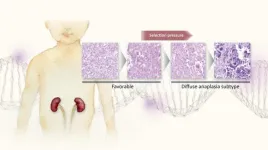(Press-News.org) In a study recently published in the PNAS on Jan. 30, a research team led by Prof. CAO Xiaofeng from the Institute of Genetics and Developmental Biology of the Chinese Academy of Sciences, in collaboration with researchers from the Southern University of Science and Technology, reported a new understanding of how light affects plant growth.
Light plays a central role in plant growth and development, providing an energy source and governing various aspects of plant morphology. Post-transcriptional splicing (PTS) has been previously discovered to generate polyadenylated full-length transcripts. These transcripts, with their unspliced introns, are retained inside the nucleus, potentially enabling plants to adapt quickly to environmental changes. Arabidopsis Protein Arginine Methyltransferase 5 (AtPRMT5), which is involved in the formation of the spliceosome, has recently been identified as critical to the splicing of PTS introns.
However, the precise processes that govern post-transcriptional regulation during the initial exposure of young, etiolated seedlings to light have remained largely unknown.
In this study, the researchers focused on the role of post-transcriptional splicing (PTS) in photomorphogenesis—the stage of development when seedlings are first exposed to light. They found that light controls the PTS of genes that regulate photosynthesis in the mesophyll cells of plants. This process is co-regulated by two proteins: AtPRMT5 and Constitutive Photomorphogenic 1 (COP1).
The researchers used Nanopore sequencing of full-length nascent RNA to reveal that 1,411 genes undergo light-responsive PTS. These genes were subsequently classified into six groups based on different propensities.
Later, using high-throughput single-nucleus RNA sequencing, the researchers analyzed seedlings kept in continuous darkness and those exposed to light for either 1 or 6 hours. This led to the successful classification of 10 sub-tissue clusters.
Analysis of differentially expressed genes (DEGs) revealed that about half (3,193 out of 6,224) of these DEGs were predominantly enriched in mesophyll cells. Intriguingly, the researchers discovered that genes involved in light-associated PTS showed significant expression in mesophyll cells.
This work further established that the splicing-related factor AtPRMT5 works in tandem with the E3 ubiquitin ligase COP1 (a primary repressor of light signaling pathways) to coordinate light-induced PTS in mesophyll cells. This coordination facilitates chloroplast development, photosynthesis, and morphogenesis, allowing plants to adapt to changing light conditions.
This study provides important insights into the cell type-specific regulation of PTS, which is essential for the onset of photomorphogenesis. It also provides a deeper understanding of the complex mechanisms by which plants acclimate and transduce the environmental signals through specific cell types and tissues.
END
Researchers study role of post-transcriptional splicing in plant response to light
2024-02-02
ELSE PRESS RELEASES FROM THIS DATE:
Gene-editing offers hope for people with hereditary disorder
2024-02-02
A group of patients with a hereditary disorder have had their lives transformed by a single treatment of a breakthrough gene-editing therapy, according to the lead researcher.
The patients from New Zealand, the Netherlands and the UK have hereditary angioedema, a genetic disorder characterised by severe, painful and unpredictable swelling attacks. These interfere with daily life and can affect airways and prove fatal.
Now researchers from the University of Auckland, Amsterdam University Medical Center and Cambridge University Hospitals have successfully treated more than ten patients with the CRISPR/Cas9 therapy, ...
New molecule from University step closer to treatment for rare disease
2024-02-02
A molecule created at the University of Auckland is one step closer to becoming a treatment for an extremely rare and severely debilitating neurological disorder called Phelan-McDermid syndrome. Children with the disorder showed significant improvements in a phase two clinical trial in the US, Neuren Pharmaceuticals, which is listed on the Australian Securities Exchange, said in December.
Next steps would be a phase three trial and seeking approval from the US Food & Drug Administration. The molecule, NNZ-2591, comes from work years ago ...
Machine learning to battle COVID-19 bacterial co-infection
2024-02-02
University of Queensland researchers have used machine learning to help predict the risk of secondary bacterial infections in hospitalised COVID-19 patients.
The machine learning technique can help detect whether antibiotic use is critical for patients with these infections.
Associate Professor Kirsty Short from the School of Chemistry and Molecular Biosciences said secondary bacterial infections can be extremely dangerous for those hospitalised with COVID-19.
“Estimates of the incidents of secondary bacterial infections in COVID-19 ...
Some tumors ‘grow bad’: Why a dangerous subtype of Wilms tumor is so resistant to chemotherapy
2024-02-02
An international team, led by researchers at Nagoya University in Japan, may have determined why the diffuse anaplasia (DA) subtype of Wilms tumor (WT) resists chemotherapy. This subtype grows even when it has a high burden of DNA damage and increases the mutation rate of tumor protein 53 (TP53), a gene that plays a critical role in the regulation of cell growth and division. The team’s findings, published in Modern Pathology, suggest new ways to treat this subtype.
WT, also known as nephroblastoma, is the most common childhood cancer originating in the kidney. Fortunately, the survival rate of adolescents ...
Disrupted cellular function behind type 2 diabetes in obesity
2024-02-02
Disrupted function of “cleaning cells” in the body may help to explain why some people with obesity develop type 2 diabetes, while others do not. A study from the University of Gothenburg describes this newly discovered mechanism.
It is well known that obesity increases the risk of insulin resistance and type 2 diabetes. It is also well known that some people who gain weight suffer from the disease and others do not. The reasons for these differences are not clear, but they are related ...
USC launches School of Advanced Computing
2024-02-02
USC President Carol Folt launched the university’s first new school in more than a decade: the USC School of Advanced Computing, a cornerstone of her $1 billion advanced computing initiative. The school seeks to educate all students, regardless of their major, in the ethical use of computing technology as part of the president’s Frontiers of Computing initiative.
Gaurav Sukhatme — a professor of computer science and electrical and computer engineering, and executive vice dean of the USC Viterbi School of ...
A clutch stretch goes a long way
2024-02-02
Kyoto, Japan -- Cell biology has possibly never jumped to the next level in the same way.
In multicellular organisms, cell migration and mechanosensing are essential for cellular development and maintenance. These processes rely on talin, the key focal adhesion -- or FA -- protein, central in connecting adjacent cellular matrices and enabling force transmission between them.
Talins are commonly considered fully extended at FAs between actin filaments -- or F-actin -- and the anchor-like integrin receptor.
Yet, a research ...
Psychological care delivered over the phone is an effective way to combat loneliness and depression, according to a major new study
2024-02-02
The study, led by a team based at the University of York and Hull York Medical School and at Tees, Esk and Wear Valleys NHS Foundation Trust, found levels of depression reduced significantly and the benefits were greater than those seen for antidepressants.
Participants in the study reported their levels of emotional loneliness fell by 21% over a three-month period and the benefits remained after the phone calls had ceased, suggesting an enduring impact.
The Behavioural Activation in Social ...
Insulin prices in US are more than twice as high as in other wealthy nations
2024-02-02
The gross price of insulin in the U.S. is more than nine times higher than in 33 high-income comparison nations, according to a new RAND report.
Although the cost differences of insulin between the U.S. and other nations varied depending on the comparison country and the type of insulin, U.S. prices were always higher -- often five to 10 times higher -- than those in other countries. The new report updates findings from earlier RAND work about U.S. insulin prices.
After accounting for rebates and other discounts often offered by drug ...
My love language is peer-reviewed research
2024-02-02
Feb. 1, 2024, TORONTO – From the Five Love Languages to the concept of “Happy Wife, Happy Life,” popular culture is riddled with ideas of how sex and relationships are supposed to work, but does the science back these ideas up? According to Faculty of Health Assistant Professor and Research Chair in Relationships and Sexuality Amy Muise, the answer is frequently no.
Ahead of Valentine’s Day, Muise, also director of the Sexual Health and Relationship (SHaRe) Lab, can offer alternative theories that are supported by her research and other literature in the ...



